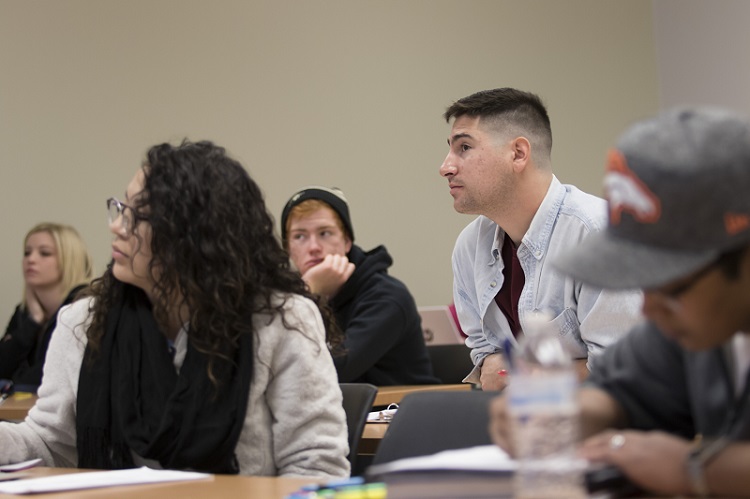
ClassroomProject

Many of our students have been given the message many times that they are not “smart” before they even enter Metropolitan State University of Denver (Astin, 2016). We live in a stratified and hierarchical system that ranks opportunities by “smartness.” Students have gotten the message from what neighborhood they live in, which high school they attended, the grades they received, not being in “gifted” programs, not being in honors classes, not taking AP exams, not applying or being told not to apply to more prestigious colleges, taking college entrance exams (e.g., the SAT), college placement tests, remedial classes, what major they decided to pursue and/or going to community college.
Now, as they sit in our classrooms, what does a student mean when they say they are “not smart”? What are the implications for their identity as to whether they belong here, as a learner, as a college student and as a major in X? How might it impact their belief in being successful in college? For faculty members, how do we think about and use the word “smart”?
Take a SIP of this: I’m smart vs. I’m not smart
A little bit of background is useful here. In the early 20th century, scientists began to categorize “smartness.” It was used to rank, sort and classify people based on ethnicity, race, class, gender and disability. The IQ test was designed by Alfred Binet to diagnose students who needed extra instruction; but Binet thought it should not be used as a unitary measure of “intelligence” (Castles, 2012, Murdoch, 2007). However, when Lewis Terman at Stanford reformulated the test (Stanford-Binet) and created the intelligence quotient, it was mass-marketed as a test to determine career choices based on a fixed intelligence level.
At around the same time, the U.S, Army used mental tests in World War I to determine who would be an officer and to rank and categorize populations of people based on the score (Gould, 1996). From this, there is a direct line to educational policies that “sorted” students into college or career “tracks”; the SAT, which promoted the idea of “smartness”; and who was worthy of going to college based on race, class and gender.
For the reasons stated earlier, the word “smart” has a negative connotation for many of our MSU Denver students and they believe they are “not smart.” Therefore, as faculty members, we need to consider how we use the term in our classes and think about our meaning of it. Do you use it when you think about students’ prior knowledge? Do you associate being “smart” with high test scores and good grades?
There are many negative effects of K-12 school tracking, acceleration, honors classes and labels of “special education” and “gifted”; there’s a notion that if you “struggle,” then you are not “smart.” Often, students in “gifted” programs or honors classes develop negative attitudes about their “smartness” if they can’t keep up with the workload or don’t believe they should have any trouble learning quickly.
If you have 30 minutes:
Let students know they can be successful in your class even if they have not been successful before. Include that message in your syllabus or course policies. Have it on a slide on the first day of class.
Watch Carol Dweck’s TED talk: https://www.ted.com/talks/carol_dweck_the_power_of_believing_that_you_can_improve?language=en
“Stereotype Threat” (e.g., female students will not do as well on a difficult math test if they are reminded that females don’t do as well as males on standardized tests). Watch Claude Steele. How Stereotypes Affect Us and What We Can Do – Claude Steele
Ways to promote a broader definition of “smartness”:
- Incorporate the opportunity for students to revise assignments and indicate that new learning is one way of being smarter.
- Give written feedback to students without a grade attached. Most students will look for the grade first and not act on the feedback.
- Encourage rough-draft thinking. Allow students to make mistakes and normalize it by telling them that mistakes are part of the learning process.
- Point out when students show effort in understanding something confusing that there are many ways of being “smart.”
- Break down stereotypical ideas of “smartness,” especially in STEM fields.
- Deemphasize grades on tests and emphasize learning of ideas and growth over the semester. More details about how to do this will be in a later SIP.
- Reframe student “deficits” and lack of “knowledge” into opportunities for growth.
Some SIPs to connect to:
SIP 4.8 Challenging students’ mental models: dealing with “expectancy effect”
SIP 1.5 Classroom Assessment Techniques
Still thirsty? Take another SIP of smart vs. I am not smart
Visit the Well at http://sites.msudenver.edu/sips/ for more great ideas and resources for Strong Instructional Practices in your higher-education classroom.
References:
Astin, A.W. (2016). Are you smart enough? How colleges obsession with smartness shortchanges students. Stylus Publishing.
Castles, E.E., (2012). Inventing intelligence: How America came to worship IQ. Praeger.
Dweck, C.S., (2006). Mindset: The new psychology of success. Random House:
Gould, S.J., (1996). Mismeasure of man. W.W. & Norton Co.
Murdoch, S., (2007). IQ: A smart history of a failed idea. John Wiley & Sons.
Steele, C.M., (2010). Whistling Vivaldi: How stereotypes affect us and what we can do. W.W. & Norton Co.

